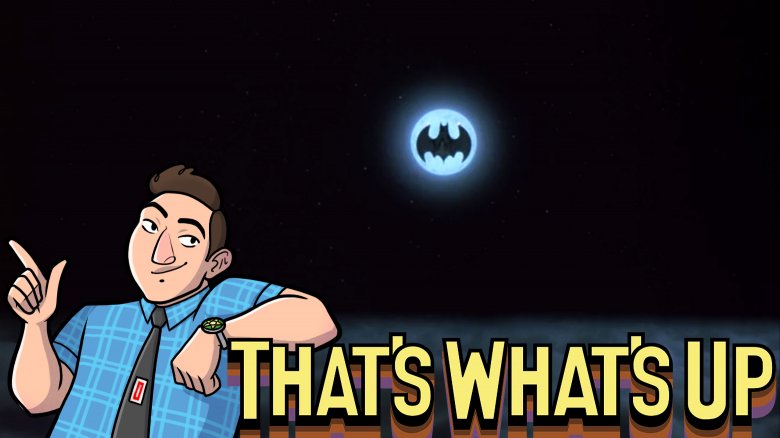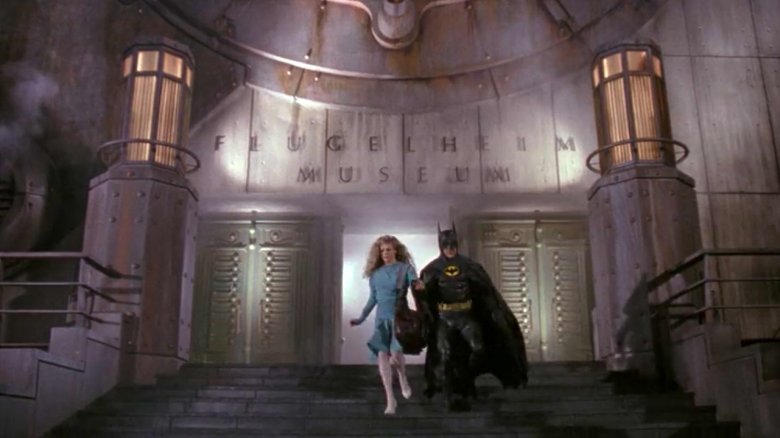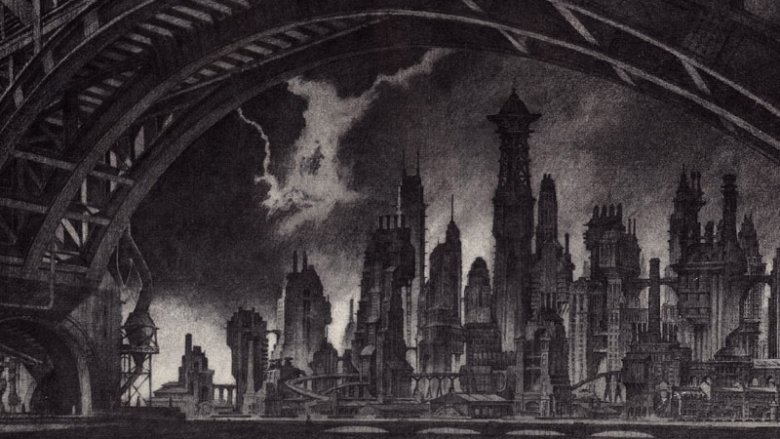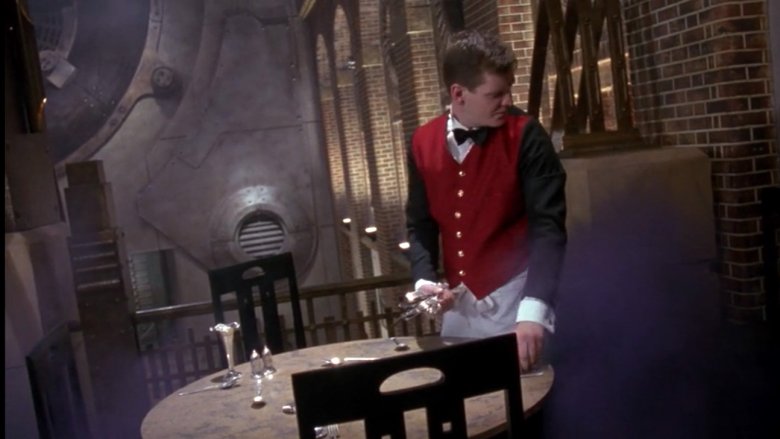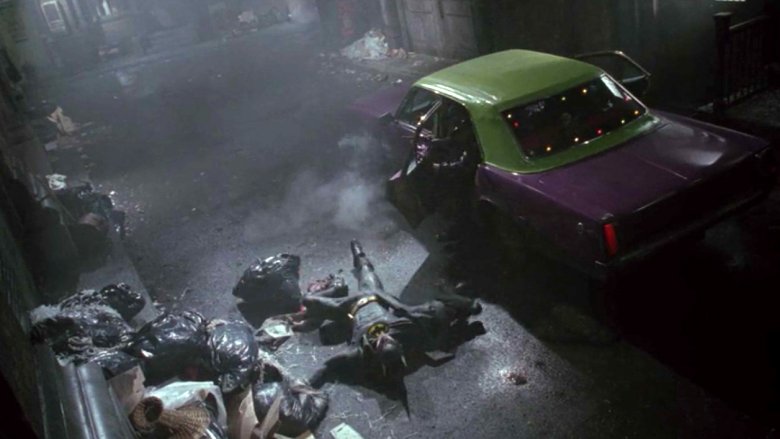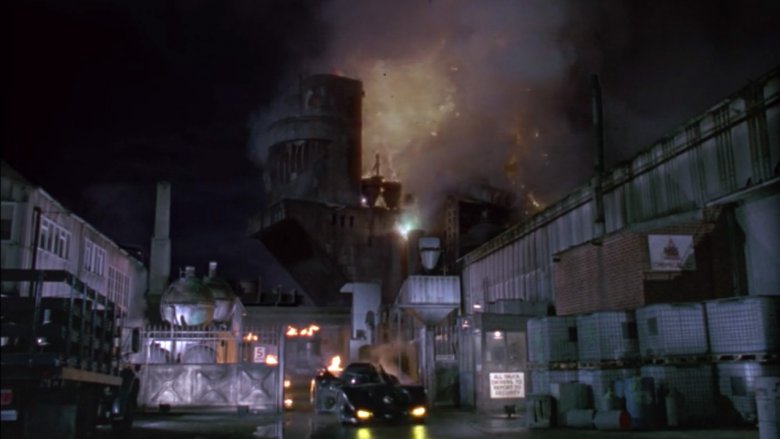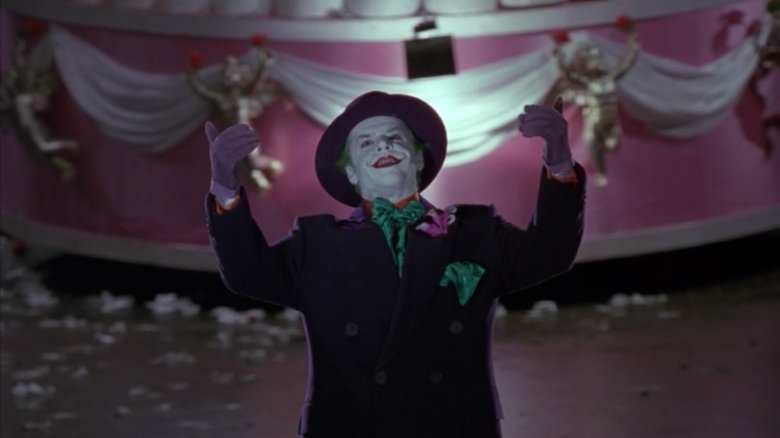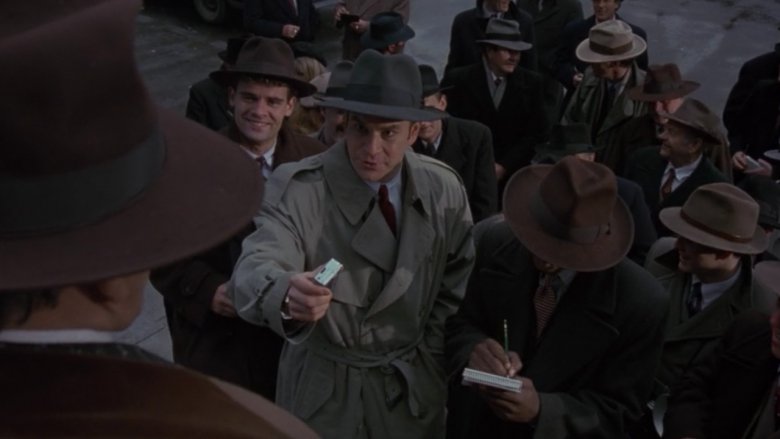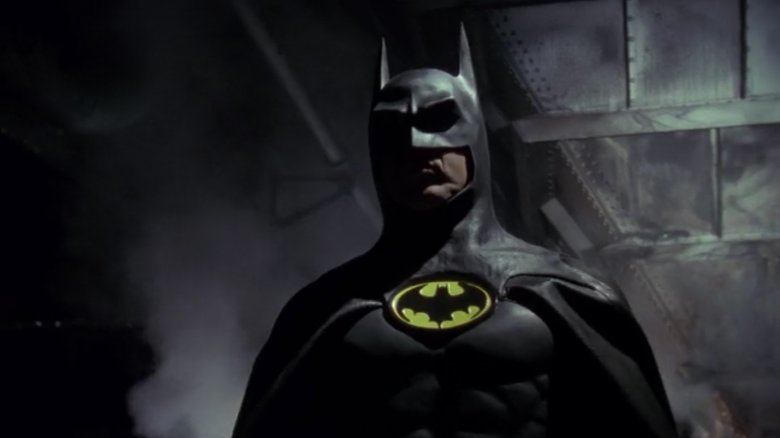That's What's Up: What The 1989 Batman Movie Got Right, And What It Got Wrong
Each week, comic book writer Chris Sims answers the burning questions you have about the world of comics and pop culture: what's up with that? If you'd like to ask Chris a question, please send it to @theisb on Twitter with the hashtag #WhatsUpChris, or email it to staff@looper.com with the subject line "That's What's Up."
Q: What did the 1989 Batman film get right? What did it get wrong? — @_Miller_Andrew_
If you weren't around in 1989, I don't think I can accurately describe just how huge the Batman movie was. I mean, I was only six, and I remember how that logo was everywhere in the marketing blitz that led up to it, and as a kid who would literally watch two hours of the Adam West show every single day, I was beyond stoked. Sitting in the theater, two months before I turned seven, I loved everything about that movie, from "I'm Batman" all the way to the Bat-Signal lighting up the night at the end.
When I watched it again, though, only a few months later on a VHS tape that I'd literally been saving for the special occasion of staying home sick from school, I remember being really disappointed. Something was just off about the whole thing, and in the 30 years since, I've held onto that feeling and become a genuine Batman '89 hater. That doesn't mean that it didn't do anything right, though, so in the interest of keeping it positive, let's start there.
Gotham looks great
Aesthetically speaking, Batman '89 is amazing. That's not really a surprise; strong visuals have always been Tim Burton's best feature as a director, especially when he's dealing with the surreal, tangibly cartoonish worlds that he created in movies like Beetlejuice and Pee-Wee's Big Adventure. With Batman, though, he and designer Anton Furst took it to the next level.
Both Burton and screenwriter Sam Hamm described their vision of Gotham City as being like Hell itself bursting through the concrete and building a city, and Furst turned that idea into a dark, claustrophobically cramped, and perpetually smoky take on New York that gave the movie this fantastic atmosphere. It's a weird kind of Art Deco Industrial Gothic, where buildings that look like they've been riveted together from sheet metal with massive vents are flanked by sleek modernist sculptures and light fixtures, and it's all shoved up right next to each other. The Flugelheim Museum façade, for instance, is right next to the City Hall facade where the Joker and his henchmen gun down his rival mobsters. It's all one big soundstage, which is not only a great example of how cramped Burton's Gotham is, but also helps to underline the unreality of everything that's going on.
That same aesthetic would progress through the movies, getting even weirder in Batman Returns and then hitting its wildly over-designed apotheosis when Joel Schumacher, Burton's hand-picked successor, took over. And honestly? For all that he's criticized for his aesthetic choices—and rightly so, for the most part—Schumacher's vision of Gotham as a weird neon-soaked hellscape where highways and buildings are held aloft by giant Art Deco statues is one of the things I absolutely love about those movies. There's a character to Gotham, a constant visual reminder that this is a world built on a strange premise, where dressing up as a bat and haunting the night is a perfectly logical and effective response to tragedy.
It's great. So great, in fact, that it permanently changed the Gotham City of the comics, too.
Anton Furst: Destroyer
Before Batman '89, Gotham City was actually pretty realistic—or at least as realistic as a city could be while still being home to a billionaire vigilante who drove around in a rocket car fighting crime and a seemingly endless supply of abandoned warehouses. It had character, sure, but it was a character that was very much informed by its real-world counterparts, with legendary Batman writer Denny O'Neil famously referring to it as being like Manhattan "at eleven minutes past midnight on the coldest night in November."
There had, of course, been some weirdness to it before. Dick Sprang, one of the most prominent early Batman artists, was well known for littering his version of Gotham City with giant props, like gargantuan coffee cups perched as advertisements on top of buildings, which would inevitably be used as deathtraps or obstacles in rooftop chases. Since the end of the Adam West show in 1969, however, creators had moved away from that kind of visual in an effort to shake the show's campy reputation. Batman '89 brought it all roaring back.
Furst's designs for Gotham were so striking—and the movie was such a monumental success—that DC opted to redesign Gotham to bring it more in line with that "hell bursting forth from concrete" idea so many people had loved on the screen. They even had an in-continuity reason for it. In 1992, the same year Batman Returns came out, a story called "Destroyer" ran through all the Batman books that saw the "soulless concrete boxes" of the realistic Gotham blown up by an aesthetically devoted bomber to reveal the beautiful Furst-designed buildings that had been lurking behind them the whole time.
I honestly don't think we would've gotten the beautifully timeless, retro-futurist Art Deco Gotham of Batman: The Animated Series, complete with supercomputers that existed alongside black-and-white TVs, if Batman '89 hadn't gotten there first and loaded up its city with people who dressed like they were in the '40s. It was a great look, and even after the billion-dollar success of the Dark Knight trilogy, where Gotham City was just, you know, Chicago, that image of moonlit industrial deco has stuck with the city ever since.
Furst, incidentally, would go on to design the interiors for Planet Hollywood restaurants.
Gothic campiness
It isn't surprising that Batman '89 would look back to the past for its aesthetic. As much as it was lauded at the time as a film that would take Batman back to his darker roots—producer Michael Uslan said at the time that he wanted a Batman "totally removed from camp" — it's pretty clear in retrospect that Burton's vision isn't really drawn from the comics. It's just updating the goofiness of the '60s show for the late '80s and adding a bunch of murders.
It's more apparent in Batman Returns, which lifts its entire "Penguin runs for mayor" plot from the show, but it's not exactly hard to spot in the first one, either. The scene where the Joker attacks the museum for his "date" with Vicki Vale, for instance, is undeniably inspired by the TV show. It's got the dutch angles, the brightly colored knockout gas, and the henchmen running around in matching jackets. The only way it could be more of a campy throwback is if it had been introduced by William Dozier's breathless narration setting the scene with "Mean-while, at the Flugelheim Museum..."
The thing is, it works. While it was often looked down on in the late '80s for being disrespectful to the source material—again, hilarious in retrospect given how many of those episodes were lifted beat-for-beat from the comics of the era—Batman '66 was a really good show. More than that, it was a cultural touchstone whose reach went far beyond the comics, becoming the thing that most people thought of when they heard the word "Batman." The movie had to address it in one way or the other, and using it as a foundation for an updated version was a solid idea.
Also the soundtrack rules
Whoever got the idea of getting Prince to do an entire concept album of songs about Batman and the Joker was a genius, especially since it led to Warner Bros. producing some completely weird comics about Prince fighting against his own evil alter ego, Gemini. They're kind of hard to find, but trust me, they're amazing.
Let's see here, what else. Oh, Michael Gough is really good as Alfred, especially in the scene when he entertains Bruce Wayne and Vicki Vale with a story about Bruce as a goofball kid. And the scene of the TV news reporters looking super gross after being warned against using cosmetics that have been tainted with Smylex is some top-notch late-'80s RoboCop satire.
And that's it. That's everything the movie did right. Now let's talk about what it did wrong.
Batman is actually very bad at being Batman
The first thing that happens to Batman in this movie, after he makes a dramatic entrance, is that he gets shot and falls down. The first time he fights the Joker's henchmen, he's knocked unconscious and unmasked. He's really bad at being Batman.
And that's on purpose. Uslan might've wanted to ditch the camp, but in a 1989 interview with Cinefantastique, screenwriter Sam Hamm talked about how he and Burton wanted comedy that was rooted in the idea that, as Hamm said, "he keeps finding out what a really, really bad idea it is to be a costumed vigilante. It's an inherently comic premise." He's not wrong, but that also means that Batman's triumphant return to movie screens was built around the idea that being Batman was a stupid idea.
That's the major divergence from the '66 show. There, the comedy came from the fact that Batman was the straight man to all the weirdness around him, that he was the hyper-competent counterpoint to a truly useless police force that couldn't even bring down Egghead without calling a superhero to do it for them. Which, in turn, is one of the reasons that the show holds up in a way that the movie doesn't. They both present Batman as the product of a truly silly premise, but one of them tells you it's a good thing. The other tells you that your hero is stupid for being your hero.
Batman kills a whole lot of people
Not that 1989's Batman is particularly heroic, at least by superhero standards. Over the course of the movie, Batman kills a ton of criminals, including bombing a factory and throwing henchmen off the clock tower to their deaths. Opinions on this one vary, but in the whole "should Batman kill people" argument, I come down pretty hard as a purist. Maybe it's just me, but I find a billionaire who, as Hamm put it in that interview, "has a sick hobby" to be a lot easier to root for if he's not also a mass murderer. Burton's Batman, on the other hand, has a body count that's pretty comparable to his arch-villain's, and he isn't even the one Prince was writing songs for. Put it all together, and you've got a movie called Batman that doesn't seem to want you to like Batman. Even Alfred isn't on board with this whole costumed vigilante scheme, and tries to get Vicki Vale involved so his employer has something else to focus on that doesn't involve bat-shaped boomerangs. No one is on board with this movie's entire premise!
I should note here that none of this is really a reflection on Michael Keaton. I love that dude, and he actually does some really great work with the material, especially in terms of playing Bruce Wayne as exactly the kind of distant weirdo that you can imagine realistically deciding to become a vigilante. If nothing else, "because I bought it in Japan" is one of the best line deliveries in a movie, and considering it's stacked up against Jack Palance wheezing "youuuuu... are my numbahhh onnnne... guy," that's saying something.
I will say that as good as he is as Bruce Wayne, I don't think he's a great Batman. That's less about performance than physicality, though. Despite having the best eyebrows of anyone to ever play Batman—seriously—he never really looks like a superhero. Instead, he looks like... well, like a 5'9" actor in an uncomfortable leather suit who falls down a lot.
To be fair, though, with Tim Burton at the helm, Keaton was probably the best-case scenario. Burton does, after all, tend to cast from a small group of actors that he likes to work with, and in that respect, Keaton getting the job right after Beetlejuice makes a lot of sense. If this movie had happened a few years later, we might've been living in some kind of horrifying nightmare world where Johnny Depp was Batman.
The Joker's not great either
Again, that's not necessarily a knock on Jack Nicholson's performance. He's incredibly charismatic and memorable in the role, and if anybody had a face that was built to wear a maniacal grin, it's him. He even works in the sense of updating the campiness—it's absolutely believable that the Joker, as played by Jack Nicholson, would put in an order for matching henchman jackets.
In terms of a character arc, though, the Joker's not actually that compelling. The movie insists on having an origin story, and while that scene of the Joker removing his bandages and seeing his face for the first time in that horror-show back-room surgery is great, there's not much of a change between the Joker and Jack Napier. He's already evil, he's already offering up theatrical catchphrases when he murders someone, and the dude is even already wearing a purple suit when he shows up to the Axis plant for his scheduled appointment with a vat full of chemicals. The only big change is that his crimes get a little more ambitious and theatrical.
And then, of course, is the part where they tie Napier into Batman's origin. Like Batman killing the Joker at the end, it's the kind of thing that makes sense following the conventional rules of an action movie, where there has to be some kind of personal stake at play for the heroes. Unfortunately, superhero stories have their own weird set of rules and genre conventions. Batman doesn't—or at least shouldn't—need a reason to fight the Joker beyond the part where he's literally trying to murder the entire city with poison gas. Adding another level to that in an effort to make us care more about the personal side of the conflict is just muddying the waters, and raising the question of why Batman would continue fighting crime once he'd gotten his revenge.
The best character is actually Alex Knox
So what does that leave us with? First, we have a hero who's so bad at his job that he crashes his billion-dollar bat-shaped fighter jet immediately after failing to kill one (1) person who is also a bright green and purple murder clown, arguably the single most visible target since the Death Star. We have a villain who's incredibly charismatic, has a personal soundtrack composed entirely of bangers composed by the dude who wrote "Nothing Compares 2 U" and "Purple Rain," and who freely admits that his catchphrase is absolute nonsense, but who also wants to murder an entire city with a scary parade. We have a love interest who, I'm sorry to say, is barely there in terms of character development. Who does that leave us with to root for?
The answer: Alex Knox.
If it's been a while since you've seen it, Knox is Vicki Vale's smart-mouthed coworker who has been assigned to get to the bottom of this whole "Bat-Man" story going around Gotham. He's the one who fearlessly asks sarcastic, loaded questions to crime bosses, clowns on Bruce Wayne's eccentricities, and faces down a poison gas riot with a bandana over his mouth and a baseball bat. That dude rules, and he gets absolutely nothing in this movie, beyond the distinction of being the most likable character.
Which means, for those of you paying attention, that in a movie about Batman that represents the first time he had been in movie theaters for 23 years, that was built as a tentpole film to kick off a franchise and absolutely succeeded, the most likable character is some dude who works at a newspaper who was played by Arliss from Arli$$. The only way that should ever be true is if the "dude who works at a newspaper" is Clark Kent, but Warners didn't manage to pull that one off, either.
Also there are too many points on the logo
And that's Batman '89. It's got fantastic aesthetics, genuinely great moments, and interesting performances, but it's ultimately not a great movie. The characters aren't great, the plot is all mixed up, and for all its goodhearted attempts to update the public perception of Batman, it feels torn between Burton and Hamm wanting to make a campy deadpan comedy and the producers wanting a straight, darker take on Batman. That's a trend that would continue, too. Batman Returns has some of the most striking images of the entire franchise, but the plot is a Frankenstein stitched together from ideas that make no sense when you jam them up together.
But at the same time, I have to admit that it's a movie with a strong legacy. I mentioned before that we wouldn't have gotten the beautiful design of Batman: The Animated Series without Furst doing the design for the movies, but it's fairer to say that we wouldn't have gotten BTAS at all without it. It really did succeed in restoring Batman to pop culture prominence, and—along with the availability of books like Year One, Dark Knight Returns, and Arkham Asylum in mainstream bookstores—bringing readers to the comics, too.
Plus, it paved the way for us to eventually get Batman & Robin, a movie that's way better than Batman.
Yeah, you heard me.
Each week, comic book writer Chris Sims answers the burning questions you have about the world of comics and pop culture: what's up with that? If you'd like to ask Chris a question, please send it to @theisb on Twitter with the hashtag #WhatsUpChris, or email it to staff@looper.com with the subject line "That's What's Up."
